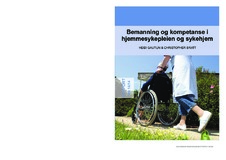| dc.contributor.author | Gautun, Heidi | |
| dc.contributor.author | Christopher Bratt | |
| dc.date.accessioned | 2020-06-07T21:06:10Z | |
| dc.date.accessioned | 2021-04-29T14:01:45Z | |
| dc.date.available | 2020-06-07T21:06:10Z | |
| dc.date.available | 2021-04-29T14:01:45Z | |
| dc.date.issued | 2014 | |
| dc.identifier.isbn | 978-82-7894-522-3 | |
| dc.identifier.issn | 0808-5013 | |
| dc.identifier.uri | https://hdl.handle.net/20.500.12199/3438 | |
| dc.description.abstract | This report provides a description of the results from a recent study among employee representatives on planning for staffing and skill-mix in local (municipal) long-term care. The study included 431 employee representatives with a membership at The Norwegian Nurses Organisation’s. They were employed at either nursing homes (56 %) or home care services. Most informants were women (93 %). Three research questions were explored: (i) Which factors affect planning and level of staffing and skill-mix in local long-term care today? (ii) What do employee representatives from long-term care services consider optimal staffing and skill-mix in nursing homes and home care respectively?; (iii) To what extent does staffing affect the quality of services and job-satisfaction among employees? i. Factors affecting planning and level of staffing and skill-mix: Most informants indicated that financial reasons and available staff were important factors affecting planning of levels of staffing. Many informants also indicated that professional judgements and considerations for employees working hours were important. Our results showed large variations in planned skill-mix in relation to the number of users and residents. Results showed that sickness absence was the most important reason for deviations between planned and actual levels of staffing. Less than half of the informants indicated that temporary workers were used to cover for sickness absence. Many used unskilled workers as replacements. The main reasons for lack of replacement were related to difficulties with actually finding temporary workers, in particular skilled nursing staff, when needed. Pressure from management to avoid replacement because of financial reasons was another reason. ii. Attitudes towards optimal staffing and skill-mix: In nursing homes, respondents preferred relatively high levels of nursing staff and staff with an education from other health sciences. An increase in number of residents (and hence nursing needs) was preferrably dealt with by increasing staff with an educaiton from other health sciences, rather than nursing staff. Employee representatives from home care services indicated a greater need for nursing staff. Informants from both nursing homes as well as home care services indicated a particular need for specialized nurses. The majority of the employee representatives believed that the introducation of “normative levels of staffing” would contribute to higher quality of services. However, many also believed that such a norm could be utilized as a maximum standard. Initiatives directed towards increased competences and skill-levels among employees as well as more direct planning towards the needs of users and residents could proof more important than introducing a norm for staffing levels. iii. The effect of staffing levels on quality and job satisfaction: Informants indicated a large time pressure within both types of long-term care services. The majority experienced time pressure on a daily or weekly basis. Nevertheless, quality of nursing care, patient safety and professional reliability were evaluated as good. Aspects related to nutrition, hygiene and other care needs were however less well attended to. Only half of the informants indicated that they had enough time for follow-up of the needs of users and residents to develop appropriate initiatives. Lowest score was found for possibilities for social activities. Analyses confirmed an association between levels of staffing and quality of services. This association was strongest for levels of staff with an education from other health sciences. Most informants indicated high levels of job satisfaction and good collaboration at the workplace. They experienced high work load and levels of sickness absence were high. There were some variations across health regions in the degree to which professional judgement affected planning of levels of staffing as well as well as in the degree to which employee representatives experienced pressure from management to avoid temporary workers. Largest pressure from management was experienced by informants from large (> 50000 inhabitants) and medium sized municipalities. Informants from small municipalities (< 3, 000 inhabitants) were more likely to report the use of temporary workers with an education from other health sciences to cover for sickness absence among nursing staff. | en |
| dc.description.abstract | I denne rapporten beskrives funn fra en spørreundersøkelse om bemanningsplanlegging og kompetansesammensetning blant 431 av Norsk Sykepleierforbund sine tillitsvalgte i sykehjem og hjemmesykepleien. Tre hovedproblemstillinger står sentrale: 1. Hva påvirker planlegging og status for bemannings- og kompetansesammensetning? 2. Hva mener tillitsvalgte i tjenestene er optimal bemannings- og kompetansesammensetning? 3. Hvilken betydning har bemanning for tjenestenes kvalitet og for arbeidsmiljøet til de ansatte? Ifølge informantene er det hensynet til økonomi og tilgjengelig helsepersonell som i størst grad påvirker planlagt bemanning. Hovedgrunnen til eventuelle avvik er høyt sykefravær. Funnene tilsier også at de tillitsvalgte er ambivalente til å innføre en standard bemanningsnorm for sykepleiere, og at det kan være viktigere for kvaliteten med tiltak for kompetanseheving. | no_NB |
| dc.publisher | Oslo Metropolitan University - OsloMet: NOVA | |
| dc.relation.ispartofseries | NOVA Rapport 14/14 | |
| dc.subject | NOVA--Helse velferdstjenester--Helse | |
| dc.title | Bemanning og kompetanse i hjemmesykepleien og sykehjem | no_NB |
| dc.type | Report | |
| fagarkivet.source.pagenumber | 106 | |
